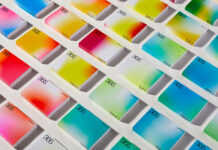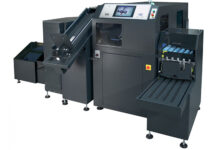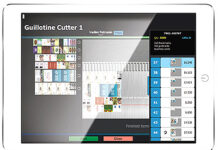by: Amy Bauer
Delivering high-quality results and offering the best value to customers in print project finishing are the goals underlying a range of innovations for printers and binders. These new cutting and trimming technologies are streamlining processes and reducing labor costs. The fewer times an operator must intervene during a job, the greater the production speeds and the lower the chance for errors. Here are some of the industry’s latest developments.
Hands-Free Automation
Smaller, on demand book orders require a nimble staff and machinery to fulfill the requests quickly and cost-effectively. The Challenge Machinery Company’s CMT series of on demand book trimmers offers fully automated book-of-one production trimming with the new Txe and TxL control systems. Barcodes printed on the precut book blocks send the job dimensions to the trimmer for complete automated set-up. This exclusive feature requires zero human intervention between books, no matter their size differences.
Standard Finishing Systems has designed its new Standard Horizon HT-80 automated three-knife trimmer to trim books of varying thicknesses, one after another, for on demand book production. The HT-80 can trim books off-line or operate in-line with several Standard Horizon perfect binders. It features the “intelligent automation” built into all Horizon post-press products. An intuitive, icon-based, 10.4″ color touch screen assists with automated setup, including the infeed, jogging, and knives. Up to 200 custom jobs can be stored in memory, and the HT-80 is compatible with Horizon’s pXnet bindery management system.
Push-button programming also is a feature of the Baumcut 31.5 and Baumcut 26.4 programmable cutters, from Baumfolder Corporation, which offer ease of operation and minimal maintenance. The heavy-duty, fully hydraulic cutters can store up to 99 programs with 6,464 cut steps, with a large central liquid crystal display indicating the data in the selected language. Safety features include infrared safety beams; two-hand, timed cut release; and covered rear table. A built-in table light and optical cutting line ensure precision.
Muller Martini’s Orbit three-knife trimmer boasts complete changeovers within three minutes with full automation and can process a wide range of book sizes without special kits. SmartPress technology provides constant, gentle pressure on the materials, allowing more time for evacuation of air for precise trimming. Individual servo control eliminates makeready on many functions and improves performance by separating drive line. The Orbit’s controlled transport system includes special belts and servo motors that lift the books and move them into position. Precise control of knives to stick contact reduces grinding costs.
Sizing up the Job
Accommodating jobs of all sizes can be a challenge, especially when a shop’s square footage is limited. New technology is addressing the varied requirements of wide-ranging print requests. Perfecta USA has introduced the 92 AWR (36″) paper cutter with automatic trim removal. The 92 AWR is tailored for smaller shops that have a large amount of printed jobs with gutters but do not have the available floor space that the larger machines require. The 92 AWR joins the list of automatic trim removal cutters from 45 to 88 inches available from Perfecta.
For the past couple of years, an 18 ½” paper cutter has been the standard for copy centers that work with 12×18″ paper stocks. But more manufacturers now are offering print engines that have a 13×19″ capability, which has created new challenges that 18 ½” cutters can’t handle, notes Matt Roth, vice president of Spiral Binding Co. “Spiral Binding Co. does not manufacture cutters, but we only sell the ‘best -in-class’,” Roth says, “including products from Challenge Machinery, Duplo USA, and MBM Corporation.”
Flexible Features
New innovations are improving the way paper cutters accommodate jobs. Heidelberg has introduced a new generation of POLAR high-performance cutters and cutter models in widths from 26″ to 69″. These machines offer an array of new options for cutting and paper handling, including swivel/tilt back gauge; down-holder in front of the knife to prevent mixing and shingling of multiple-ups; down-holder at back gauge, which holds down curly sheets; and Fix-o-Mat for correct alignment of irregular lifts. Autotrim provides automatic waste removal to increase productivity, and its air knife handles plastic sheets or static-loaded materials, while the AntiStick Knife prevents residual material from sticking.
Duplo USA Corporation also has addressed varied needs with its 800PA Hydraulic Cutter, which is designed to offer precision cutting for documents on a wide variety of paper stocks and weights. Its special low-friction surface aluminum alloy cutting bed requires no polish or waxing and won’t rust over the life of the cutter. It comes standard with an air-cushion table, allowing heavy paper stacks to be moved easily across the cutting bed. A color touch-screen control panel allows for ease of programming. Safety features include a large working area with side table, full light beam curtain, and dual-palm-cut buttons.
Multi-Tasking Machines
Printers and binders also are finding flexibility with machines that perform multiple tasks, sometimes even within a single step, thereby reducing the need for separate operations or outsourcing. Technifold’s Multi Tool originally was made to produce either guillotine-quality trimming or die-quality micro-perforating on any popular folding machine. It now can perform these two functions simultaneously, adding more flexibility in finishing single- or multiple-up jobs on the folder. A slight change to the construction of the perforating anvil allows the cutting and perforating operations to be conducted at the same time. The distance between cut and perforation can vary from ¼” up to 1 1/8″.
Rollem International also is focused on multitasking. The company has introduced its new 2D digital finishing system for multiple-up photo cards, postcards, greeting cards, and more. The two-directional system edge trims the press sheet in both directions, slits each card, and applies fine-quality score and cut-score. This method eliminates the need for guillotine cutting and additional labor as the cards are finished in one process. A folder can be added for complete automation from press sheet to finished product.
Clean Cuts
The condition of a book’s spine, or backbone, is among the first things customers notice, and a strong, unmarred backbone helps ensure a book’s longevity. Jorson & Carlson Company spent about a year of research and development in creating the Back Bone Buster, which eliminates backbone chips and tears. The Back Bone Buster is a unique side knife application for trimmers that pre-cuts the bind of the backbone prior to the side knife cut. The product works for both saddlestitched and perfect bound books and is ideal for any binder that cuts books ½” or less.
Industry innovation, as seen through these companies and their products, reaps rewards for printers and binders, who can use these tools to provide higher-quality printed materials more quickly and more affordably to customers.




